The post Niranjana Maharaja and Sivarama Maharaja inspect appeared first on SivaramaSwami.com.
Niranjana Maharaja and Sivarama Maharaja inspect
Navadwipa mandala parikrama (Album with photos)
Srila…
→ Dandavats.com

Navadwipa mandala parikrama (Album with photos)
Srila Prabhupada: Although a Vaishnava is the most exalted person, he is prideless and gives all respect to everyone, knowing everyone to be the resting place of Krishna. If one chants the holy name of Lord Krishna in this manner, he will certainly awaken his dormant love for Krishna’s lotus feet. (Sri Caitanya-caritamrta, Antya-lila, 20.25.26)
See them here: http://goo.gl/qinFLz
Hare Krishna! ISKCON South Africa Releases Annual Report
It is a…
→ Dandavats.com

Hare Krishna! ISKCON South Africa Releases Annual Report
It is a great pleasure to present to you the ISKCON South Africa Annual report for 2014. The theme for the report is #ISKCONinAction. We pray it reflects the love, dedication, inspiration and compassion that the many members of ISKCON represent in their every day actions along with ISKCON’s many great friends and well-wishers. In this report you will hear from His Holiness Bhakti Caitanya Swami, the Co-GBC for South Africa who along with the National Secretaries reflects on the great strides ISKCON continues to make and the build-up too much awaited significant events in 2015 and 2016.
Read the entire article here: http://www.dandavats.com/?p=16798
Srila Prabhupada journey to the West
→ simple thoughts
Vicaru Das WTSP–Harinam Ruci .
In the port of Calcutta on August 13,1965; carrying only a small suitcase, an umbrella and a bag of dry cereal A.C Bhaktivedanta Swami as he was known at the time climbed up the steep gangway onto a cargo ship named the Jaladuta.
The ensuing journey presented considerable hardship, Srila Prabhupada wrote of some sea sickness and on the thirteenth day of the voyage during the passage through the Arbian Sea,he suffered a massive heart attack. He was concerned that he might pass away but in his uneasy sleep that night he had a dream, a vision, Lord Krishna appeared; the Lord was in an open boat along with His other incarnations, Krsna was rowing the boat and the boat was pulling Srila Prabhupada’s ship with a rope. Krsna was smiling at Srila Prabhupada and was pulling the ship all the way to America! Srila Prabhupada did not write about this occurrence in his diary but simply drew a line through those troubled days declaring that he had passed over a great crisis in the struggle between life and death. Years later he related these events to his followers.
After the crisis Srila Prabhupada regained his strength and recommenced his entries in the diary after the ship docked in port Said Egypt. Then after crossing the mediterranean Sea the Jaladuta passed through the Straits of Gibralter and into the atlantic ocean Uncharacteristiclly the ocean appeared like a placid lake the atlantic crossing was so effortless that the ship’s captain remarked that he had never seen anything like it. After a total of thirty five days the ship at last berthed in Boston at Commonwealth Pier, on September 17 at 5;30 am. The next day the Jaladuta continued to New York, where Srila Prabhupada disembarked onto a lonely Brooklyn pier to begin his mission in the west…….
Srila Prabhupada the pure devotee of Srimati Radharani ki Jay
(May we continue in fulfilling Srila Prabhupada mission)
Srimad Bhagavatam Class By H.G.Sankarshana Prabhu (video)
Given…
→ Dandavats.com

Srimad Bhagavatam Class By H.G.Sankarshana Prabhu (video)
Given in Vrindavana, Krishna Balaram mandir, 12.04.2015
Watch it here: http://goo.gl/ZE8RZI
April 13th, 2015 – Darshan
→ Mayapur.com
The post April 13th, 2015 – Darshan appeared first on Mayapur.com.
Vrindavan Kirtan Mela 2015 Vrajras Day 07 by HG Madan Prabhu
→ Gouranga TV - The Hare Krishna video collection
Vrindavan Kirtan Mela 2015 Vrajras Day 07 by HG Madan Prabhu
New Body for Lord Jagannatha in Puri
→ ISKCON Malaysia
BY DEVASIS SARANGI
Nabakalebar 2015
#Puri, Odisha, India — derived from the Sanskrit words Naba or new and Kalebar or body, literally meaning New Body
It is an ancient ritual associated with Jagannath Temple, Puri, Odisha, India (60kms from the city of #Bhubaneswar)when the Idols of Lord Jagannath, Balabhadra, Subhadra and Sudarshan are replaced by a new set of Idols.
A year which has two months (Adhika masa) of Ashadha as per the Hindu Calender is auspicious for conducting the ceremony. This usually occurs every twelve to nineteen years. The Deities are made from a special type Neem wood known as Daru Bramha.
Preparations for the ceremony start in the month of Chaitra.
Last ceremony was done in the year 1996. Next ceremony will be held on 2015. More than 5 million devotees are expected to visit the temple during the Nabakalebar of 2015.
No ordinary Neem tree can be used to make the deities . Certain well defined criteria must be satisfied by the tree before it is labelled a Daru Brahma fit for deities making.
Sankha (conch), Chakra (disc), Gada (mace/club), Padma (lotus) are the required marks on the tree to be designated Daru Brahma.




Locating the four holy trees requires divine intervention.
As per long standing tradition the Priests of the Jagannath Temple (Puri) worship Maa Mangala at the Kakatpur Mangala Temple. It is said the Goddess appears to them in their dreams revealing the location of the holy trees.
The countdown to the Nabakalebar of Lord Jagannath starts with the formation of the search party that would go out to locate the “Holy Tree”. Search party consists of
- 1 member of the Pati Mahapatra family
- 20 Dayitapatis
- 1 Lenka
- 9 Maharanas
- 16 Brahmanas
- 3 Deulakaranas
- 30 police officers &
- 2 inspectors of police
The function begins after the Big Midday Offering to Lord Jagannath. The blessings of the Lord is sought.A twelve foot garland called Dhanva Mala made specially for this day is offered to the lord and His siblings. After worshipping the Lord, the garland is given to the Pati Mahapatra family, who is meant to lead the procession.
He would from then on carry the huge garland until the sacred tree is located. Upon spotting the tree the Garland is placed on top of a coconut and offered to the Tree. Apart from the garland, the robes of Lord are given to the descendants of Bitarachha Mahapatra family, Dayitapaties, and the Pati Mahapatra who would tie it as a turban on their head while going on the procession. Both the garland and the clothes are significant in the sense that it is indicative of the Lord himself traveling with the team.
Patta clothes used by the Lord are also given to the Lenka family representative and the nine Maharanas who accompany the group. They are the actual carpenters who build the new chariots every year and who will make the new Jagannath deities as well. Once the Mekap family members touch the forehead of each members of the procession with the Lord’s sandal, the procession officially takes off.
Their first halt would be the palace of the King of Puri (Gajapati) where they are required to seek his permission to continue on the holy mission. After staying here for two days and doing meditations and prayers, the team starts out for Kakatpur, a village 50 miles of Puri to the famous temple of Maa Mangala. After reaching the village, they take rest for several days while the oldest. Dayitapati sleeps inside the temple. He has a dream during this stay in which goddess Mangala tells him the exact location where the trees can be found.
The tree for each of the four deities will be in a different place. This may take as long as 15 days to one month.During this entire period the group would eat the prasada of goddess Mangala. But sometimes provision is made for MAHAPRASAD to be brought from Puri.
King Cobra (Naga) is found at the foot of the daru (designated tree) as per the selection criteria.



Once the tree is located that fulfills all the required conditions, a yagna is performed in front of it. Now the team moves to a temporary thatched hut nearby and stays in it till the trees are felled.




The cutting of the tree would commence at an auspicious time and with prescribed rituals. The Pati Mahapatra first touches the tree with a golden axe followed by the Dayitapati who touches it with a silver axe. Lastly, the head wood carver of the Maharana family would touch it with an iron axe. During the tree cutting, the 108 names of God are chanted incessantly.



Once the tree is felled, the entire trunks along with its branches are placed in a wooden cart and dragged by the Daitapatis and the others in the group to the Temple.



The logs are kept inside the temple in a place known as Koili Vaikuntha. Koili means “burial ground” and Vaikuntha means “Heaven”. It is the place where the old deities will be buried and the new ones made.

The carving of the images begin with three oldest 7 of the main wood carvers setting on to work on the image of Lord Jagannath. The three oldest wood carvers will be the main sculptors for the deity of Lord Jagannath. The images of Lord Balabhadra and Devi are simultaneously carved by other two teams consisting of three carvers each.More than 50 carpenters work as assistant to the main carvers.The work is done with utmost confidentiality and not even the head priest of the temple is allowed to visit the place of work. There is a special enclosure inside the temple premises where the carving of the Lord is done. The enclosure is open on the top but is attached with very strong doors. The wood carvers are not supposed to consume anything (eat, drink or smoke) once inside the enclosure. The carvings are completed in 21 days and during these 21 days the carvers are not supposed to leave the temple premises. They would sleep in the temple courtyard in the night and have their dinner in the form of Lords Mahaprasad.
Devotional songs are sung outside the Koili Baikuntha day and night during throughout this 21 days period. This continuous singing of devotional songs is called “Akhand Bhajan”. While this is done by devadasis and temple musicians, shlokas from the Vedas are chanted continuously by Brahmin priests.
When the new deities, are made, they are carried inside the inner sanctum of the temple and placed in front of the old deities, facing them. This is again an act that is done with utmost confidentiality as nobody is allowed inside for a Darshan of the Lord, not even the temple priests.
The three new deities are carried inside only by descendants of the Dayitapati family. Once they are safely inside, only the three eldest Dayitapati members can stay. No puja is done at this time and no food is offered. Of the four Jagannath’s height is 5' 7", and His outstretched arms measure 12 ft. across. He weighs so much that when they carry Him, 5 persons must be on each arm, 20 on His backside, and more than 50 in front pulling. Balabhadra is a bit lighter. His height is 5' 5" and His arms are also 12 ft. across. Subhadra is less than 5', and light. Sudarsana is in a long log-shaped form only. However, this log is 5' 10" in length.
The rights of the Great Transformation are accorded only to the Daitapatis as they are considered to be the descendants of the Daitapati who was the first worshipper of the Lord Jagannath (Juggernaut word is derived from this word).

This ceremony takes place three days before the great Chariot Festival called Rath Yatra (Chariot pulled by humans to this day)

The transformation is complete once the “Brahman” or the life force (also referred to as pinda) is transferred from the old deities to the new.
There are different rules attached to this act that the Daitapatis must adhere to. These are:
- The three Dayitapatis must be blindfolded.
- They must bind a piece of Lord Jagannath’s cloth around their hands before the transfer can begin.
- They should not have shaved since the first day of the search party procession. This is considered to be the disappearance ceremony of Jagannath also. Traditionally, after a member of the family passes away, the son does not shave for ten days, out of respect for the deceased. The house is also whitewashed after the death of any family member. And since Lord Jagannath is considered to be the Head of their respective households, they are required to have their houses whitewashed after this ceremony.
- The children and all Dayitapati family members wear new clothes on this day of the “transfer”. This rite is considered to be the most auspicious ritual of all in Jagannath Temple. It is this ceremony itself that is the actual Nabakalebar Yatra, or Transformation Ceremony of Lord Jagannath. The three Dayitapati members fast and meditate the whole day inside the temple. Only after midnight does the transfer of the “Life Force” occur, and that too in total silence.
What’s interesting here is that no Daitapati till date has been able to experience what actually is this “Brahman”.
When asked of their experience at this time, the Dayitapatis say, “It is very difficult to express what Brahman is. It cannot be seen or touched. Our eyes are blindfolded and our hands are covered with cloth when we carry it. Yet a powerful feeling is very much present, like a rabbit jumping in our hands. This is our experience. Beyond this, exactly what this Brahman is that is so powerfully felt, nobody is able to say”.
During the midnight, the old deities are carried on the shoulders of the Dayitapatis and buried in the Koili Vaikuntha before dawn.
There are three separate graves for the three deities, but all the previous Jagannaths are laid to rest in the same grave, one on top of the other. It is believed that if anybody from outside this select group happens to see any of this ceremony, be it from a roof top or otherwise, they will surely die.
The Government of Odisha therefore orders a full blackout of light on this one night in the whole town of Puri.
On the morning of the second day the new deities are seated on the altar, the “Ratna-Singhasana”. On this second day, the daily routine of the temple finally begins again, after a lapse of nearly 58 days. Sweet-smelling flower garlands and new garments arc given to the new deities, food is offered, and puja is done. Devotees can again come inside for darshan. And on the third day the new deities emerge from the temple for the biggest Chariot Festival.
The Navakalebar draws millions of people from across the world to #Puri, Odisha #India. Nabakalebar is one of the biggest festivals in the country and draws the most number of people to the holy city of #Puri.
Information sources: Shreekhetra, SJTA, Nabakalebara by Bibudharanjana,Wiki.
Photo Credit for pics of Nabakalebar 1996 — SJTA, Puri
Do plan your visit to for Nabakalebar 2015 (Facebook page PuriNabakalebar2015) to witness this once in a lifetime opportunity.
If you like what you read you can motivate me further by hitting the recommend button below.
I am reachable at devasissarangi@gmail.com,https://twitter.com/devasissarangi
New Vrindaban Hosts Rose Pruning Workshop at Prabhupada’s Palace of Gold Rose Garden
→ New Vrindaban Brijabasi Spirit
Prabhupada’s Palace Rose Garden Springtime Pruning Workshop
By Lilasuka dasi
“I’m really happy to have all these people out here helping us prune Prabhupada’s Palace Roses at this workshop. It’s a big job!” smiles Gopalasyapriya dasi, who has been heading up the Palace Rose Garden crew for about 13 years.
Her steady, regular garden workers Purnima dasi, Mukunda dasi, and Srimati dasi are with her at the workshop Sat. April 11 to Monday April 13, 2015 at Prabhupada’s Palace of Gold Rose Garden. They were joined by Jeanette, who often works at the Palace Lodge, as well as by three experienced gardeners from the local “Ohio County Master Gardeners” group, including their president, who all came to increase their knowledge of rose pruning and planting, while simultaneously helping the Palace crew.
Paul Zimmerman, the expert rosarian giving the workshop, explains, “This transformation of the Palace Rose Garden from regular chemical usage to a totally sustainable organic rose garden is a two to three year process. They got a great start last year, 2014, following two main steps that I recommended.” Paul’s website is Paul Zimmerman roses
First, Paul had told them to evaluate the roses, keeping careful written scores of each rose group. High points went to the roses that prospered well without their previous chemicals, while low points went to roses which had trouble on the new organic program. He wanted to find out which types of roses would do best with organic gardening.
The second step was to change their usual pruning time. For years, Gopa and her crew have been pruning back the Palace roses in the fall and piling mulch over them to protect them for the winter.
“Last year I suggested they try letting them go for the winter and then pruning them back in the spring time instead, like I do on most of my organic, sustainable rose gardens back home,” explains Paul.
That’s why Paul came to the Palace this sunny weekend in April– to see how the new method is working out.
“Roses are like people. They’re all different. We can see by this rose garden that you had a very rough winter! Down in North and South Carolina the spring pruning works great! But your rose garden had special challenges. It’s evident that this particular method of spring pruning may not work with Prabhupada’s Palace roses. But that’s alright. It was a starting point and now we’ll simply adjust the methods to suit Prabhupada’s roses. The harsh snowy and icy conditions of the 2015 WV winter, combined with the winds up here behind Prabhupada’s Palace, what to speak of the constant thawing and freezing that I’ve heard about is forcing us to make the decision to go back to the method of pruning back and mulching in the fall. It will work fine.” Paul asserts.
This second year of the transformation to organic, 2015, is the year to remove the rose plants which got low scores on last year’s evaluation, because these plants just don’t do well with this sustainable program. They will be replaced with hardier plants. He points out the new rose plants lined up, waiting to be planted during the weekend workshop.
Gopa tells us, “We also have to group all the like roses that are scattered around the garden, digging them up if necessary in order to put them with their matching groups for a more harmonious look.”
As a result of the careful evaluation process they did in 2014, Gopa and her crew found that there were 10 varieties out of the total approximately 55 varieties of roses that did not do well under these organic conditions. So these 10 varieties will be removed from the garden and 150 new, more sustainable plants will be planted as replacements. There are about 800 rose plants altogether at the Palace. Many of the variety of plants around the Palace are started at the Palace greenhouse.
When asked how the workshop is going, Paul smiles. “It’s going great! The sun is out. The gardeners who are here from Wheeling are learning a lot, and the Palace of Gold roses are benefitting from their work. I think the Palace Rose Garden will continue to get better and better.”
HH Bhakti Sundar Goswami – The Purpose of Life / BG 8.5 – Sunday Feast
→ Kalachandji's Audio Archive
HH Bhakti Sundar Goswami / CC Madhya 8.91-100
→ Kalachandji's Audio Archive
CC daily 72 – CCM 5.103-113 – The Lord’s extraordinary mercy causes astonishment and delight
→ The Spiritual Scientist
CC daily Podcast:
Download by "right-click and save content"
Gita 06.35 – The supreme teacher offers guidance – and confidence
→ The Spiritual Scientist
Gita Verse-by-verse Study Podcast:
Download by "right-click and save content"
Anzac weekend
→ Bhakti Lounge - The Heart Of Yoga in Wellington
Sundarananda and Prema Manjari
→ Ramai Swami
Around 1980 Prema Manjari’s mother and father attended a book fair and met the devotees. They became interested in Krsna Consciousness and shared that interest with their daughter.
Establishes It’s Supremacy
→ Japa Group
Invest in your spiritual life
→ KKSBlog
(Kadamba Kanana Swami, 05 April 2014, Durban, South Africa, Ratha Yatra Lecture: The secret of spiritual advancement)
 If we do not have a connection with Srimad Bhagavatam, then spiritual life becomes dry! Chanting becomes difficult and then the four regulative principles become very narrow and gradually with time, we start craving for more space. Even though we have all the knowledge, even though we have been enlivened in Krsna consciousness and even though we have been so surrendered, at one point it will become too narrow! So the Bhagavatam is very important because it is the science that explains everything about Krsna and through Bhagavatam, we connect with Krsna. It keeps us focused on seeing who Krsna is, where Krsna is and how everything connects with Krsna… It is essential! For our faith to grow, we need to invest.
If we do not have a connection with Srimad Bhagavatam, then spiritual life becomes dry! Chanting becomes difficult and then the four regulative principles become very narrow and gradually with time, we start craving for more space. Even though we have all the knowledge, even though we have been enlivened in Krsna consciousness and even though we have been so surrendered, at one point it will become too narrow! So the Bhagavatam is very important because it is the science that explains everything about Krsna and through Bhagavatam, we connect with Krsna. It keeps us focused on seeing who Krsna is, where Krsna is and how everything connects with Krsna… It is essential! For our faith to grow, we need to invest.
When you enter into a new job, in the beginning you have to learn everything and then after a while, when you have been working for a number of years, then you are totally expert. You can do it real quick. So it gets easier over time. As you get into a routine, it gets easier. But spiritual life is the opposite. In a material situation, as you get more expert, you have to invest less but not in spiritual life.
In spiritual life, as time passes, we have to invest more and if we do not invest more, our faith will dry up! What was enough yesterday, is not enough anymore. You know, may be last year we did all these things and it was enough to keep us enthused but now, we do the same things but we are not feeling enthused because we have not invested more. We have to invest more; that is the way of spirit life!
Bhagavatam-daily 178 – 11.10.20 – Expose the tricks by which the mind denies our mortality
→ The Spiritual Scientist
Bhagavatam-daily Podcast:
Srimad Bhagavatam Class By HH Radhanath Swami Maharaj at Iskcon…
→ Dandavats.com

Srimad Bhagavatam Class By HH Radhanath Swami Maharaj at Iskcon Kanpur 11-04-2015 (video)
Watch it here: http://goo.gl/MBUhww
ISKCON Studies Institute Conference 2015
The ISKCON Studies…
→ Dandavats.com

ISKCON Studies Institute Conference 2015
The ISKCON Studies Institute cordially invites you to attend its upcoming conference to be held at Radhadesh (Belgium) from May 22-24, 2015. This year’s conference theme is Devotional Ethics, Community, and Practice in Caitanya Vaisnavism.
Read the entire article here: http://www.dandavats.com/?p=16790
ISKCON Sri Lanka School Preaching – “Heavy Chanting”…
→ Dandavats.com

ISKCON Sri Lanka School Preaching - “Heavy Chanting” of Hare Krishna Mahamantra by School Children (2 min video)
Watch it here: http://goo.gl/ATUOJg
Hare Krishna! Srila Prabhupada’s Jaladuta Diary entries
April…
→ Dandavats.com

Hare Krishna! Srila Prabhupada’s Jaladuta Diary entries
April 1965: While approaching the Scindia Steam Navigation Company in Bombay to sponsor his passage to America, Srila Prabhupada received one of their complimentary diaries. He used it at first as an appointment book. Once his voyage to America on the Jaladuta began in August of that year, he made regular entries in the diary to record the events of the journey.
Read the entire article here: http://www.dandavats.com/?p=16783
Hare Krishna! TOVP Tour Daily Diary: Day 24 – $325,000 pledged…
→ Dandavats.com

Hare Krishna! TOVP Tour Daily Diary: Day 24 – $325,000 pledged at New Jersey TOVP Presentation
After kirtan and abhisheka of the Padukas, a few local leaders, including Madhupati prabhu, Temple President of both New Jersey temples, and Devakinandana prabhu, spoke and began the program. Radha Jivan then introduced Ambarisa prabhu who had come for both the New Jersey programs, and together with Jananivas prabhu they urged the 150+ devotees to make a sacrifice for the TOVP despite the large financial burden of the new facilities. Devotees responded enthusiastically and the pledges amounted to over $325,000 by the end of the program. Prasadam was served to all the Vaishnavas.
Read the entire article here: http://www.dandavats.com/?p=16780
Dedicated diciples in Ljubljana Iskcon temple perform Puja…
→ Dandavats.com

Dedicated diciples in Ljubljana Iskcon temple perform Puja ceremony (2 min video)
Watch it here: http://goo.gl/Z7EnoN
Goshala ISKCON Mayapur (8 min video)
Beautiful, happy, protected…
→ Dandavats.com

Goshala ISKCON Mayapur (8 min video)
Beautiful, happy, protected cows!
Watch it here: http://goo.gl/zeODvP
This is as of today
→ SivaramaSwami.com
The post This is as of today appeared first on SivaramaSwami.com.
Hear from our very special guest His Grace Devakinandan Dasa this Sunday, April 12,2015
→ ISKCON Brampton

Sunday Love Feast for All | ||||||||||||||||||
| ||||||||||||||||||
| ||||||||||||||||||
Highlights from US Congresswoman Tulsi Gabbard’s Vedic Wedding
→ ISKCON News
Hare Krishna! Japa: An Outline
1. We all have a relationship…
→ Dandavats.com

Hare Krishna! Japa: An Outline
1. We all have a relationship with Krishna. A. We are fully and eternally related with Krishna on the spiritual platform. B. The relationship is there whether we are theists or atheists, practitioners or non-practitioners. C. We may be conscious of the relationship or not, and our consciousness may also be in various manners strong, weak or distorted. 2. If we are not pure devotees, that relationship is to some degree or another broken. A. The full relationship is prema. B. Brokenness in various ways characterizes all else. 3. Maha-mantra japa is, in the beginning, a preliminary demonstration of interest in restoring the relationship.
Read the entire article here: http://www.dandavats.com/?p=16777
Hare Krishna! List of English Words derived from Sanskrit via…
→ Dandavats.com

Hare Krishna! List of English Words derived from Sanskrit via Latin Greek Persian
Be it Greek Latin English Hindi Lithuanian – Sanskrit is the mother of all Languages. Even Scholars like Voltaire, Immanuel Kant etc believed that Sanskrit was the root of all Indo-European languages. “I am convinced that everything has come down to us from the banks of the Ganges” said Voltaire. He believed that the “Dynasty of Brahmins taught the rest of the world”.
Read the entire article here: http://www.dandavats.com/?p=16774
The Astrological Newsletter, A Gaudiya Vaishnava Publication…
→ Dandavats.com

The Astrological Newsletter, A Gaudiya Vaishnava Publication April 2015
Dandavats to the Vaishnavas. May Shrila Prabhupada be eternally glorified. Please find attached the latest issue (April 2015) of The Astrological Newsletter. This issue features a lecture Shrila Prabhupada’s that deals with astrology, the Mahabharata and the reign of King Yudhishthira over the entire world. Smt Abhaya Mudra Dasi unravels the mysteries of the Book of Revelation in the Bible. There are many other items of interest to the Vaishnava community, and as usual we appreciate your feedback. Thanks for reading. Yours in the service of the servants of Prabhupada’s servants, Patita Pavana dasa, Ed.
Read the entire article here: http://goo.gl/2DrvhB
“Prabhupada’s Vision: Our Mission”…
→ Dandavats.com

“Prabhupada’s Vision: Our Mission” Poster
Prabhupada’s Vision for New Vrindaban: Founded in 1968, Srila Prabhupada boldly envisions New Vrindaban as a sacred village known worldwide for Cow Protection, Simple Living, Holy Pilgrimage, Spiritual Education, and, above all, Loving Krishna.
Hare Krishna! Double voice amplification kirtans and the missing…
→ Dandavats.com

Hare Krishna! Double voice amplification kirtans and the missing silence
This paper is about what I call “double voice amplification kirtans.” These are kirtans in which the lead-singer sings into the microphone, after which, on the response, another devotee also sings into a microphone. The result is an uninterrupted amplification of two lead-voices throughout the entire kirtan. I think this type of kirtan is problematic for several reasons, which I explain as follows.
Read the entire article here: http://www.dandavats.com/?p=16770
Hare Krishna! Was Alexander the Great a Contempory of Canakya…
→ Dandavats.com

Hare Krishna! Was Alexander the Great a Contempory of Canakya Pandit? – the Puranic Version
Srila Prabhupada: “That is a fact-the brahmanas were accepted. They formed the advisory committee of the king. For example, Candragupta, the Hindu king, was in the age of Alexander the Great. Just before Candragupta, Alexander the Great went from Greece into India and conquered a portion. When Candragupta became emperor, he had Canakya as his prime minister. Perhaps you have heard this name Canakya?”
Read the entire article here: http://www.dandavats.com/?p=16763
15 Apr 2015 – Varuthini Ekadashi
→ ISKCON Desire Tree
Hare Krishna! Celebrating the Glories of Our Mothers
In material…
→ Dandavats.com

Hare Krishna! Celebrating the Glories of Our Mothers
In material life and its culture, where sense gratification is the goal of life, mothers don’t have a very respected and valued position at all. Indeed, it is a down-trodden and pitiful one – the mother is the slave at home! She can’t go out and enjoy life by having a career, developing her talents, and earning money. To be ‘just a mother and housewife’ is not given any importance and value as a rule.
Read the entire article here: http://www.dandavats.com/?p=16760
Vrindavan Kirtan Mela 2015 Vrajras Day 07 by Bhakta Prashant Prabhu
→ Gouranga TV - The Hare Krishna video collection
Vrindavan Kirtan Mela 2015 Vrajras Day 07 by Bhakta Prashant Prabhu
Village Council Proposed at New Vrindaban Community Dialogue
→ New Vrindaban Brijabasi Spirit
By Madhava Smullen
Nearly 40 New Vrindaban residents and board members gathered for a community dialogue on March 14th, 2015 to discuss starting a Village Council, which could provide residents with a voice and facilitate a more comprehensive community governance.
After a sweet kirtan and introductions all around that created a mood of warmth and humor, Joint Board Member Chaitanya Mangala Das introduced the topic, saying that the non-profit religious corporate structure New Vrindaban has used until now was like “trying to fit a square peg into a round hole.”
“Corporations, with their legal frameworks, rules and restrictions,” he said, “Don’t work for a more democratic body involving people in this kind of community setting.” He added that the Village Council concept was a new attempt by the Joint Boards at an ongoing effort to involve the broader community.
The inspiration behind the idea, he explained, came from a 1973 quote by Srila Prabhupada, instructing the leaders of New Vrindaban to “Go on acquiring the surrounding lands and in this way we will establish a local self-governing village, and show all the world a practical example of spiritual life as Krishna Himself exhibited in Vrindaban.”
Chaitanya Mangala further summarized the Village Council proposition with three buzz words – small, local, and simple.
“Small: the proposed council could consist of five to eight key representatives from the ECO-V and ISKCON New Vrindaban Boards, the Advocacy Sanga, and other community interests such as local non-profits or businesses,” he said.
“Local: since the new council will represent the New Vrindaban village, members will have to live in it and be able to meet face to face on a regular basis,” he went on. “And simple: there should be few preconditions made before the Council is formed, with the focus on simply getting the group in a room talking on a regular basis.”
Chaitanya Mangala also pointed out that while a subcommittee consisting of Joint Board Members Dayavira Das, Ananga Manjari Dasi, Madhava Gosh Das, and president Jaya Krishna Das, had worked on the Village Council concept, they intentionally hadn’t filled in more specific details, leaving that for the Village Council “steering committee” to do.
As the discussion opened up to the floor, Nityodita Das of the community’s Advocacy Sanga expressed his group’s appreciation that two of its top priorities – devotee care and governance – were also being made a priority by New Vrindaban leadership.
He said that apathy in the community was to some degree caused by frustration at having no avenue to influence its direction. The Village Council, if successful, would be a helpful solution.
He concluded that a more inclusive system was needed so that people could express themselves, and pointed out that in the end all parties wanted the same thing – for New Vrindaban to be a more loving, Krishna conscious, united community.
Next Jesse, also from the Advocacy Sanga, expressed appreciation for the developments but also disillusionment. After spending a year-and-a half in the Advocacy Sanga, what he saw as a similar effort to the proposed Village Council, he felt they had failed to create a bridge between the temple management and community members, and was skeptical that a new organization would have any impact. However he did hope that it would.
Advaita Das responded with an impassioned, inspirational speech in which he opined that the Advocacy Sanga was a success – and that the current plan for a Village Council wouldn’t be happening without it. He also echoed Nityodita’s thoughts on apathy being a problem in New Vrindaban, which he felt was a result of people not being appreciated and recognized.
Commenting that this was an opportunity for residents to take responsibility for creating what they want, ECO-V’s new project manager Mukunda Das suggested that they didn’t have to reinvent the wheel. “We can learn about the specifics of creating a Village Council,” he said, “From many successful intentional communities that already have Village Councils.”
Professor Burke Rochford, who has studied ISKCON since the 1970s and written many scholarly books and articles about it, was then invited to offer his reflections on the idea.
Calling it “an important conversation,” he said, “New Vrindaban, in contrast to other ISKCON temples, was specifically envisioned by Prabhupada as a community, and while that makes it a different and special place, it also makes for certain inherent challenges that other temples don’t have.”
Rochford mentioned that when he surveyed the New Vrindaban community some years ago, one thing that stood out to him was how the residents felt alienated because of the emphasis on the place (as being a holy pilgrimage) rather than on the people.
“Ten years later, the conversation is very similar,” he said. “But now’s the time for it to lead to something. This is your community, and the Village Council is an opportunity for the voices of the people to be heard.”
Rochford’s observations were echoed in the discussion that followed, with many saying they felt community members were not being put first and expressing the wish for an overall increase in focus on devotee care.
Advaita then turned the conversation back to the practicalities of a working Village Council, commenting that it was critical that the Joint Boards were represented on the Council and were attentive to the residents, to ensure that decisions are supported at the board level.
Meanwhile Nityodita offered the Advocacy Sanga’s open Wednesday meetings as a venue to continue developing the Village Council.
As the dialogue wound down, New Vrindaban co-GBC Anuttama Das observed that its general mood had been a positive one of “there may be disagreements, but let’s try to improve things together.” He quoted Bhaktivinode Thakur as saying, “progress is a gradual series of adjustments moving in the right direction.”
He acknowledged that trust needed to be rebuilt, which was a two-way street. He added that he saw the afternoon’s dialogue as real tangible progress and said, “If we work together, Krishna will continue to move us forward.”
In closing, Chaitanya Mangala said that the input and participation of every single person present mattered. He expressed that while there was no specific vision yet, the process of getting a Village Council up and running had been started.
Moving on, the Joint Boards, the Advocacy Sanga, and other groups and individuals will come together to formulate a practical plan.
“This could create a wonderful example of what Srila Prabhupada wanted us to do when he made his famous statement, ‘Your love for me will be shown by how much you cooperate to keep this institution together after I am gone,” concluded ISKCON New Vrindaban president Jaya Krishna Das.
Srimati Tulsi Gabbard’s lovely wedding (3 min video)
Here…
→ Dandavats.com

Srimati Tulsi Gabbard’s lovely wedding (3 min video)
Here are some highlights from Tulsi’s beautiful Hindu Vedic wedding on April 9, including walking down the aisle and a fire ceremony which ended with a lively kirtan.
Watch it here: http://goo.gl/9ZQu2R
Gita 06.34 – The mind is dangerous like an unstoppable storm
→ The Spiritual Scientist
Gita Verse-by-verse Podcast:



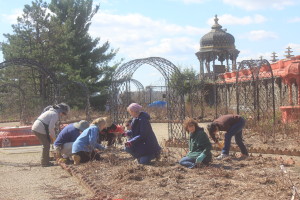
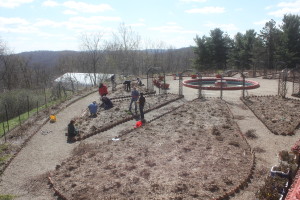
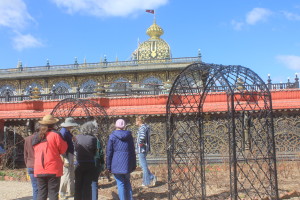
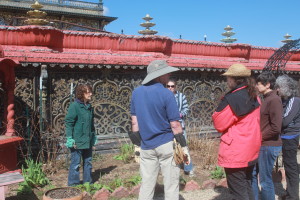
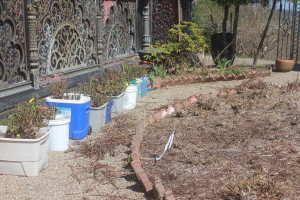
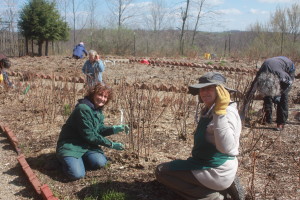
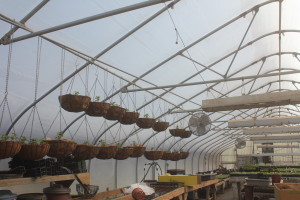


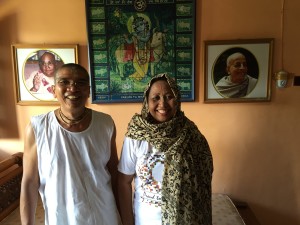
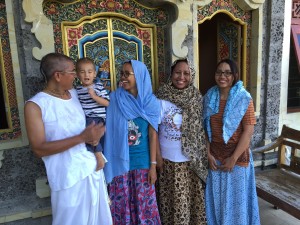
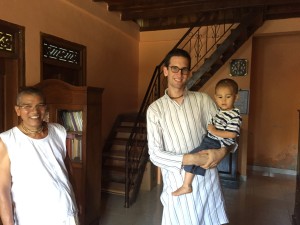
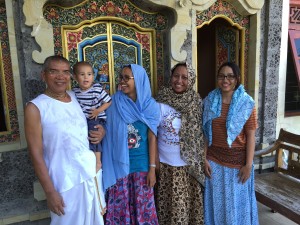


 Varuthini
Varuthini Monthly Sankirtan Festival(MSF)
Monthly Sankirtan Festival(MSF) Narasimha Caturdasi
Narasimha Caturdasi Nectar of Instruction Course
Nectar of Instruction Course
 Gift Shop
Gift Shop


